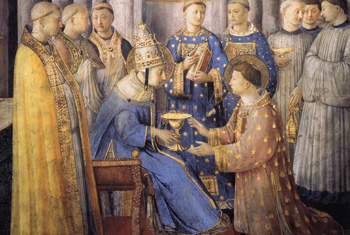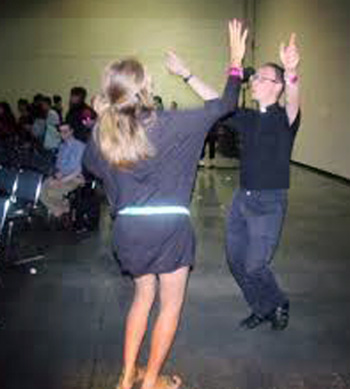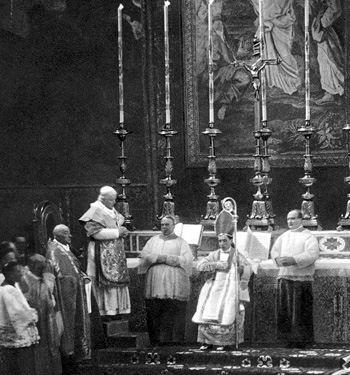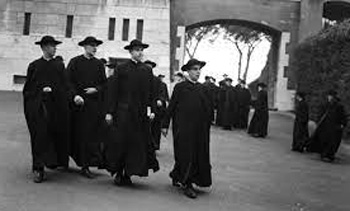Traditionalist Issues
 |
 |
 |
 |
 |
 |
 |
Dialogue Mass - CXII
The Perfection of the Clergy
Now we come to the third and most important factor of the Minor Orders elucidated by Fr. Bacuez – the perfection of those who entered the clerical state from the moment they received First Tonsure – even if all the candidates did not proceed to the final destination of the priesthood.
 This required them to be separated from the ordinary faithful and from worldly influences in order to give themselves to the things of Heaven – the reverse of the aims of Vatican II, which trumpeted equality with the laity and openness to the world.
This required them to be separated from the ordinary faithful and from worldly influences in order to give themselves to the things of Heaven – the reverse of the aims of Vatican II, which trumpeted equality with the laity and openness to the world.
For centuries before Vatican II, the Church consistently taught through numerous Saints, Doctors and Popes that a higher degree of perfection – and a correspondingly greater burden of responsibility before God – was required for those in all degrees of clerical Orders. Hence, there developed from the 3rd century on, (1) a pattern of sequential ordinations – the cursus honorum – which eventually became standardized as the customary way in which the Church could best select, prepare, prove and promote worthy candidates to higher office.
The aim to be sought in this process was the perfection of the clergy at all stages of their ecclesiastical career, including those who did not complete the full cursus.
Let us be clear
It is a familiar situation in Vatican II politics that whenever the progressivists introduced counter-traditional changes, they wrapped their explanations in vagueness, prevarication and fudging. That much is clear now. But back in 1972, few would have noticed the deception cues in Paul VI’s Ministeria quaedam by which he suppressed the Minor Orders.
 For, in order to justify turning Minor Orders into lay ministries, he had to avoid giving the impression that the liturgical ministries of the early Christians were clerical in nature, i.e., conferred in rites of ordination by a Bishop. In the document, Paul VI, using generic terms, stated that they were “entrusted to the faithful” in “a special rite” involving prayers for “God’s blessing.”
For, in order to justify turning Minor Orders into lay ministries, he had to avoid giving the impression that the liturgical ministries of the early Christians were clerical in nature, i.e., conferred in rites of ordination by a Bishop. In the document, Paul VI, using generic terms, stated that they were “entrusted to the faithful” in “a special rite” involving prayers for “God’s blessing.”
He gave no indication that the faithful who were entrusted with liturgical ministries were first constituted as clerics, i.e., men ordained by a Bishop to perform those roles. The earliest evidence for this comes from the writings of the Fathers of the Church in the post-apostolic era. The third-century Bishop, St. Cyprian, for instance, mentions in Epistle 32 that when he promoted Aurelius as a Lector, it was one of several degrees of “clerical ordination.”
A catalyst for revolution
Paul VI’s prevarication on this issue thus lent support to the reformers who had created and spread the false notion that, in the early centuries of Christianity, the clergy had no exclusive rights to exercise liturgical ministries, as these belonged to laymen and women. The corollary of this argument was that the laity should have justice restored to them with official recognition in a rite of “institution” – hence the revolutionary tenor of Ministeria quaedam.
This bad spirit of discontent had been identified and condemned by Pope Pius X who upheld the doctrine that the Church was, by nature, an unequal society composed of Hierarchy and the rest of the faithful, (2) the rulers and the ruled.
Not surprisingly, “equality” was one of the watchwords of both the French Revolution and the Bolshevik Revolution; and Card. Suenens and Fr. Yves Congar famously identified Vatican II with these anti-Catholic revolutions.
A suppression detrimental to the priesthood
What emerges very clearly from the history of Minor Orders is that they were instituted for the perfection of the clergy, as Fr. Bacuez explained:
 “Each successive ordination requires additional marks of worthiness in the candidates, whilst it also confers upon them additional graces. Thus each ordination supplies a twofold means for progress in virtue. Hence the seminary is a road whose end is perfection and along which divine grace makes them almost of necessity advance.” (3)
“Each successive ordination requires additional marks of worthiness in the candidates, whilst it also confers upon them additional graces. Thus each ordination supplies a twofold means for progress in virtue. Hence the seminary is a road whose end is perfection and along which divine grace makes them almost of necessity advance.” (3)
This immemorial system of sequential ordination rites and cumulative graces, which had been supplied by the Church for fruitful ministry in the clerical state, was brutally ended by Paul VI in 1972. One of the pretexts given in Ministeria quaedam for their suppression was that not all recipients of Minor Orders went on to be deacons or priests.
So, it was concluded ‒ by an obvious non sequitur ‒ everyone who was not in Major Orders henceforth would have to be simply members of the laity.
But in the traditional system, even where a particular cleric did not complete all the grades leading to the priesthood, he was nevertheless still in possession of the powers and graces conferred on him by his ordination for the fulfilment of his duties. And, unless he was dismissed from office or requested leave to return to the lay state, he continued to maintain his link to the chain of offices that are related to the Hierarchy.
The special status of the minor clerics
It was common knowledge among the pre-Vatican II faithful that all members of the clergy were raised to a pre-eminent position in the Church and society. (That, of course, was before “active participation” of the laity distorted the venerable and settled tradition of the liturgical ministry as the preserve of the clergy).
 At the dawn of the Liturgical Movement, Fr. Bacuez described the Minor Orders thus: (4)
At the dawn of the Liturgical Movement, Fr. Bacuez described the Minor Orders thus: (4)
“Minor Orders are far above not only all earthly dignities, but also the Levitical ministry and even the missions of those extraordinary men whom God raised up at divers times for the guidance, protection or reform of His people, Israel.”
As the dignity of the priest derives principally from his supernatural power to confect the Eucharist and forgive sins, it follows logically that those who received Minor Orders partake, albeit minimally, of the priest’s reflected radiance. Fr. Bacuez gives the reason for this:
“He who is invested with these first Orders begins to have a share in the powers of the great High Priest.” (5)
We must note the use of the word “begins”: it signifies that the man ordained in Minor Orders has been promoted to a position he could not have had as a layman, one that actually entitled him, for the first time in his life, to participate in some of the liturgical powers of the priesthood of Christ.
As it was the settled and universal tradition that only a cleric, be he in Minor or Major Orders, can fittingly perform a distinct hieratic role in the sanctuary as a result of Ordination, it follows that he must pursue a path of higher spiritual perfection. The Council of Trent stated:
 “Nothing better instructs others in piety and the worship of God than the life and example of those who dedicate themselves to the divine ministry. ... To them, as to a mirror, others direct their gaze, and in them find a source for imitation. It is very fitting, therefore, that clerics called to the service of God should so direct their life and habits that in dress, gesture, walk, word and in everything else, they show nothing except what is serious, moderate and religious”.
“Nothing better instructs others in piety and the worship of God than the life and example of those who dedicate themselves to the divine ministry. ... To them, as to a mirror, others direct their gaze, and in them find a source for imitation. It is very fitting, therefore, that clerics called to the service of God should so direct their life and habits that in dress, gesture, walk, word and in everything else, they show nothing except what is serious, moderate and religious”.
The rationale for the traditional teaching was explained by Fr. Bacuez:
“The glory of God and the sanctification of souls require the sacred minister to be the more stainless, the more saintly, the more fervent inasmuch as his relations with sanctity itself are closer and more intimate.” (6)
But the need for this acquired perfection is no longer obvious today in the post-Vatican II Church where the distinction between the sacred and the profane has been deliberately obliterated, where altar rails demarcating the place of the Holy of Holies have been removed, and where the laity are granted uninhibited access to the sanctuary.
Continued


The ordination of St. Lawrence as Deacon
For centuries before Vatican II, the Church consistently taught through numerous Saints, Doctors and Popes that a higher degree of perfection – and a correspondingly greater burden of responsibility before God – was required for those in all degrees of clerical Orders. Hence, there developed from the 3rd century on, (1) a pattern of sequential ordinations – the cursus honorum – which eventually became standardized as the customary way in which the Church could best select, prepare, prove and promote worthy candidates to higher office.
The aim to be sought in this process was the perfection of the clergy at all stages of their ecclesiastical career, including those who did not complete the full cursus.
Let us be clear
It is a familiar situation in Vatican II politics that whenever the progressivists introduced counter-traditional changes, they wrapped their explanations in vagueness, prevarication and fudging. That much is clear now. But back in 1972, few would have noticed the deception cues in Paul VI’s Ministeria quaedam by which he suppressed the Minor Orders.

A 'conservative' Vatican II priest leads cheerleaders in a routine rehearsal
He gave no indication that the faithful who were entrusted with liturgical ministries were first constituted as clerics, i.e., men ordained by a Bishop to perform those roles. The earliest evidence for this comes from the writings of the Fathers of the Church in the post-apostolic era. The third-century Bishop, St. Cyprian, for instance, mentions in Epistle 32 that when he promoted Aurelius as a Lector, it was one of several degrees of “clerical ordination.”
A catalyst for revolution
Paul VI’s prevarication on this issue thus lent support to the reformers who had created and spread the false notion that, in the early centuries of Christianity, the clergy had no exclusive rights to exercise liturgical ministries, as these belonged to laymen and women. The corollary of this argument was that the laity should have justice restored to them with official recognition in a rite of “institution” – hence the revolutionary tenor of Ministeria quaedam.
This bad spirit of discontent had been identified and condemned by Pope Pius X who upheld the doctrine that the Church was, by nature, an unequal society composed of Hierarchy and the rest of the faithful, (2) the rulers and the ruled.
Not surprisingly, “equality” was one of the watchwords of both the French Revolution and the Bolshevik Revolution; and Card. Suenens and Fr. Yves Congar famously identified Vatican II with these anti-Catholic revolutions.
A suppression detrimental to the priesthood
What emerges very clearly from the history of Minor Orders is that they were instituted for the perfection of the clergy, as Fr. Bacuez explained:

A priest, now equal to the laity, dances in a church
This immemorial system of sequential ordination rites and cumulative graces, which had been supplied by the Church for fruitful ministry in the clerical state, was brutally ended by Paul VI in 1972. One of the pretexts given in Ministeria quaedam for their suppression was that not all recipients of Minor Orders went on to be deacons or priests.
So, it was concluded ‒ by an obvious non sequitur ‒ everyone who was not in Major Orders henceforth would have to be simply members of the laity.
But in the traditional system, even where a particular cleric did not complete all the grades leading to the priesthood, he was nevertheless still in possession of the powers and graces conferred on him by his ordination for the fulfilment of his duties. And, unless he was dismissed from office or requested leave to return to the lay state, he continued to maintain his link to the chain of offices that are related to the Hierarchy.
The special status of the minor clerics
It was common knowledge among the pre-Vatican II faithful that all members of the clergy were raised to a pre-eminent position in the Church and society. (That, of course, was before “active participation” of the laity distorted the venerable and settled tradition of the liturgical ministry as the preserve of the clergy).

St. Pius X confers the cardinalate on the future Benedict XV in the solemn ceremony of the past
“Minor Orders are far above not only all earthly dignities, but also the Levitical ministry and even the missions of those extraordinary men whom God raised up at divers times for the guidance, protection or reform of His people, Israel.”
As the dignity of the priest derives principally from his supernatural power to confect the Eucharist and forgive sins, it follows logically that those who received Minor Orders partake, albeit minimally, of the priest’s reflected radiance. Fr. Bacuez gives the reason for this:
“He who is invested with these first Orders begins to have a share in the powers of the great High Priest.” (5)
We must note the use of the word “begins”: it signifies that the man ordained in Minor Orders has been promoted to a position he could not have had as a layman, one that actually entitled him, for the first time in his life, to participate in some of the liturgical powers of the priesthood of Christ.
As it was the settled and universal tradition that only a cleric, be he in Minor or Major Orders, can fittingly perform a distinct hieratic role in the sanctuary as a result of Ordination, it follows that he must pursue a path of higher spiritual perfection. The Council of Trent stated:

Priests must remain apart from the laity
for their own perfection
The rationale for the traditional teaching was explained by Fr. Bacuez:
“The glory of God and the sanctification of souls require the sacred minister to be the more stainless, the more saintly, the more fervent inasmuch as his relations with sanctity itself are closer and more intimate.” (6)
But the need for this acquired perfection is no longer obvious today in the post-Vatican II Church where the distinction between the sacred and the profane has been deliberately obliterated, where altar rails demarcating the place of the Holy of Holies have been removed, and where the laity are granted uninhibited access to the sanctuary.
Continued
- St Cyprian of Carthage (who died in 258) in his Epistle 51 stated, with reference to Pope Cornelius who became Bishop of Rome in 251, that “he was not one who on a sudden attained to the episcopate but, promoted through all the ecclesiastical offices… he ascended by all the grades of religious service to the lofty summit of the Priesthood”.
- Pius X, Vehementer nos, 1906, §8.
- Louis Bacuez SS, Minor Orders, St Louis MO: B. Herder, 1912, p. 136.
- Ibid., p. 158.
- Ibid., p. 160.
- Ibid., p. 145.

Posted February 7, 2022
______________________
______________________
 Volume I |
 Volume II |
 Volume III |
 Volume IV |
 Volume V |
 Volume VI |
 Volume VII |
 Volume VIII |
 Volume IX |
 Volume X |
 Volume XI |
 Special Edition |


